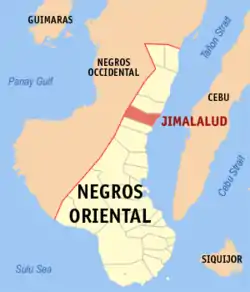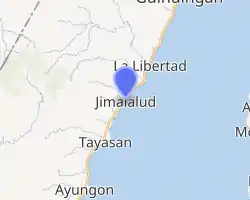Jimalalud
Jimalalud, officially the Municipality of Jimalalud (Cebuano: Lungsod sa Jimalalud; Tagalog: Bayan ng Jimalalud), is a 4th class municipality in the province of Negros Oriental, Philippines. According to the 2015 census, it has a population of 30,945 people. [3]
Jimalalud | |
|---|---|
| Municipality of Jimalalud | |
| Nickname(s): Little Big Town | |
 Map of Negros Oriental with Jimalalud highlighted | |
OpenStreetMap 
| |
.svg.png.webp) Jimalalud Location within the Philippines | |
| Coordinates: 9°58′47″N 123°12′00″E | |
| Country | |
| Region | Central Visayas (Region VII) |
| Province | Negros Oriental |
| District | 1st district |
| Founded | 1798 |
| Chartered | 1910 |
| Barangays | 28 (see Barangays) |
| Government | |
| • Type | Sangguniang Bayan |
| • Mayor | Reynaldo V. Tuanda |
| • Vice Mayor | Dante G. Zamora |
| • Representative | Jocelyn S. Limkaichong |
| • Electorate | 19,555 voters (2019) |
| Area | |
| • Total | 139.50 km2 (53.86 sq mi) |
| Elevation | 89 m (292 ft) |
| Population | |
| • Total | 30,945 |
| • Density | 220/km2 (570/sq mi) |
| • Households | 7,100 |
| Economy | |
| • Income class | 4th municipal income class |
| • Poverty incidence | 62.48% (2015)[4] |
| • Revenue | ₱86,004,882.49 (2016) |
| Time zone | UTC+8 (PST) |
| ZIP code | 6212 |
| PSGC | |
| IDD : area code | +63 (0)35 |
| Climate type | tropical climate |
| Native languages | Cebuano Tagalog |
| Website | https://www.jimalalud.gov.ph |
Jimalalud has a land area of 139.50 square kilometres (53.86 sq mi).[5][6]
History
Jimalalud was founded in 1797 as part of Tayasan. In 1910, it was separated from Tayasan and became an independent municipality.[7]
Boundless sugar cane fields, typical of the northern landscape, fill the lush lands of Jimalalud most months of the year. It has reported rich deposits of coal, copper, iron and related compounds of magnetite, pyrites and marcasite, but the lodes remain untouched. A Spanish soldier was said to have asked a native the name of the place, indicating the area. The native thought he was referring to a tree, and so informed the soldier that the tree was called a “hambabalud" (terminalia calamansanai).
In the late 1800s the Recollects built here a convent of hardwoods, an imposing structure that was reputed to be the biggest convent in the Province for over a quarter of a century. The Revolution against Spain compelled the friars to leave and the convent fell into disrepair. Jimalalud was made a town independent of Tayasan in 1910. In 1944 World War II guerillas burned down the entire town, leaving Jimalalud without a historical landmark standing. Barrio Bankal was the seat of the 7th District Government during World War II.[8]
Most times, Jimalalud is serene and green, and the plaza is the picturesque public space for imbibing the town’s pastoral ambience.[9]
Geography
Jimalalud has a land area of 139.50 square kilometers (53.86 sq mi). It is located more than 110 kilometers from Dumaguete City, the province's capital and 564.41 kilometers (350.71 miles) from the national capital, Manila. The town is bounded by La Libertad to the north & Tayasan in the south. It faces the Tañon Strait in the east while the eastern part is mostly the mountainous part of the municipality.
Barangays
Jimalalud is politically subdivided into 28 barangays with North and South Poblacion as the center of governance, trade & commerce.
| Barangay | Household Population | Number of Household[10][11] |
|---|---|---|
| Aglahug | 784 | 163 |
| Agutayon | 482 | 109 |
| Apanangon | 2,242 | 496 |
| Bae | 890 | 210 |
| Bala-as | 543 | 116 |
| Bangcal | 1,126 | 257 |
| Banog | 882 | 174 |
| Buto | 754 | 178 |
| Cabang | 534 | 122 |
| Camandayon | 934 | 227 |
| Cangharay | 1,259 | 261 |
| Canlahao | 535 | 126 |
| Dayoyo | 1,776 | 403 |
| Yli | 1,670 | 369 |
| Lacaon | 1,214 | 318 |
| Mahanlud | 907 | 245 |
| Malabago | 478 | 115 |
| Mambaid | 778 | 200 |
| Mongpong | 861 | 212 |
| Owacan | 1,427 | 343 |
| Pacuan | 1,900 | 443 |
| Panglaya-an | 1,084 | 254 |
| North Poblacion | 1,138 | 277 |
| South Poblacion | 1,862 | 457 |
| Polopantao | 1,280 | 292 |
| Sampiniton | 1,510 | 341 |
| Talamban | 696 | 194 |
| Tamao | 1,449 | 289 |
Climate
| Climate data for Jimalalud, Negros Oriental | |||||||||||||
|---|---|---|---|---|---|---|---|---|---|---|---|---|---|
| Month | Jan | Feb | Mar | Apr | May | Jun | Jul | Aug | Sep | Oct | Nov | Dec | Year |
| Average high °C (°F) | 29 (84) |
30 (86) |
31 (88) |
32 (90) |
31 (88) |
30 (86) |
30 (86) |
30 (86) |
30 (86) |
30 (86) |
29 (84) |
29 (84) |
30 (86) |
| Average low °C (°F) | 23 (73) |
22 (72) |
23 (73) |
24 (75) |
25 (77) |
25 (77) |
25 (77) |
25 (77) |
25 (77) |
24 (75) |
24 (75) |
23 (73) |
24 (75) |
| Average precipitation mm (inches) | 42 (1.7) |
34 (1.3) |
40 (1.6) |
61 (2.4) |
124 (4.9) |
188 (7.4) |
190 (7.5) |
191 (7.5) |
189 (7.4) |
186 (7.3) |
124 (4.9) |
73 (2.9) |
1,442 (56.8) |
| Average rainy days | 10.0 | 8.5 | 9.5 | 12.8 | 22.3 | 26.8 | 28.4 | 27.9 | 27.3 | 27.6 | 20.5 | 13.1 | 234.7 |
| Source: Meteoblue [12] | |||||||||||||
Demographics
| Year | Pop. | ±% p.a. |
|---|---|---|
| 1903 | 3,613 | — |
| 1918 | 17,828 | +11.23% |
| 1939 | 14,553 | −0.96% |
| 1948 | 14,639 | +0.07% |
| 1960 | 16,572 | +1.04% |
| 1970 | 18,568 | +1.14% |
| 1975 | 19,036 | +0.50% |
| 1980 | 18,863 | −0.18% |
| 1990 | 22,089 | +1.59% |
| 1995 | 23,514 | +1.18% |
| 2000 | 26,756 | +2.81% |
| 2007 | 27,728 | +0.49% |
| 2010 | 29,044 | +1.70% |
| 2015 | 30,945 | +1.21% |
| Source: Philippine Statistics Authority [3] [13] [14][15] | ||
Economy
The annual regular revenue of Jimalalud for the fiscal year of 2016 was ₱86,004,882.49, according to the record from the Bureau of Local Government Finance.
Hambabalud Festival
Each 13-15th day of January, the town celebrated its annual fiesta with "Sinulog de Jimalalud" as one of the highlight event.[16] The pageantry of its revived Sinulog keeps Jimalalud’s religious and cultural heritage alive in a colorful way. Fiesta time and other special occasions usually bring on the town’s stallions for the exciting, if brutal, spectacle of the Paaway sa Kabayo.[17]
Education
There are 3 high school in the town, the nationally-funded Jimalalud National High School in South Poblacion with extension in Baranggay Tamao & Owacan National High School, and Infant King Academy manage by Religious of the Virgin Mary (RVM).
References
- Municipality of Jimalalud | (DILG)
- "Province:". PSGC Interactive. Quezon City, Philippines: Philippine Statistics Authority. Retrieved 12 November 2016.
- Census of Population (2015). "Region VII (Central Visayas)". Total Population by Province, City, Municipality and Barangay. PSA. Retrieved 20 June 2016.
- "PSA releases the 2015 Municipal and City Level Poverty Estimates". Quezon City, Philippines. Retrieved 12 October 2019.
- "Local Government Unit of Negros Oriental Province", Department of the Interior and Local Government. Retrieved 2013-05-28.
- "About Jimalalud, Negros Oriental", Jimalalud Online Forum. Retrieved 2013-05-28.
- "Jimalalud: Brief History", Dumaguete Info Attractions. Retrieved 2019-11-21.
- "About | Cities & Towns", Negros Oriental Tourism. Retrieved 2013-05-28.
- "About | Cities & Towns", Negros Oriental Tourism. Retrieved 2013-05-28.
- 2015 Census of Population, Negros Island Region", Philippine Statistics Authority. Retrieved 2019-11-20.
- Jimalalud, Province of Negros Oriental", PhilAltas. Retrieved 2019-11-20.
- "Jimalalud: Average Temperatures and Rainfall". Meteoblue. Retrieved 6 May 2020.
- Census of Population and Housing (2010). "Region VII (Central Visayas)". Total Population by Province, City, Municipality and Barangay. NSO. Retrieved 29 June 2016.
- Censuses of Population (1903–2007). "Region VII (Central Visayas)". Table 1. Population Enumerated in Various Censuses by Province/Highly Urbanized City: 1903 to 2007. NSO.
- "Province of". Municipality Population Data. Local Water Utilities Administration Research Division. Retrieved 17 December 2016.
- "Jimalalud - Negros Oriental", Dumaguete. Retrieved 2019-11-19.
- "About | Cities & Towns", Negros Oriental Tourism. Retrieved 2013-05-28.